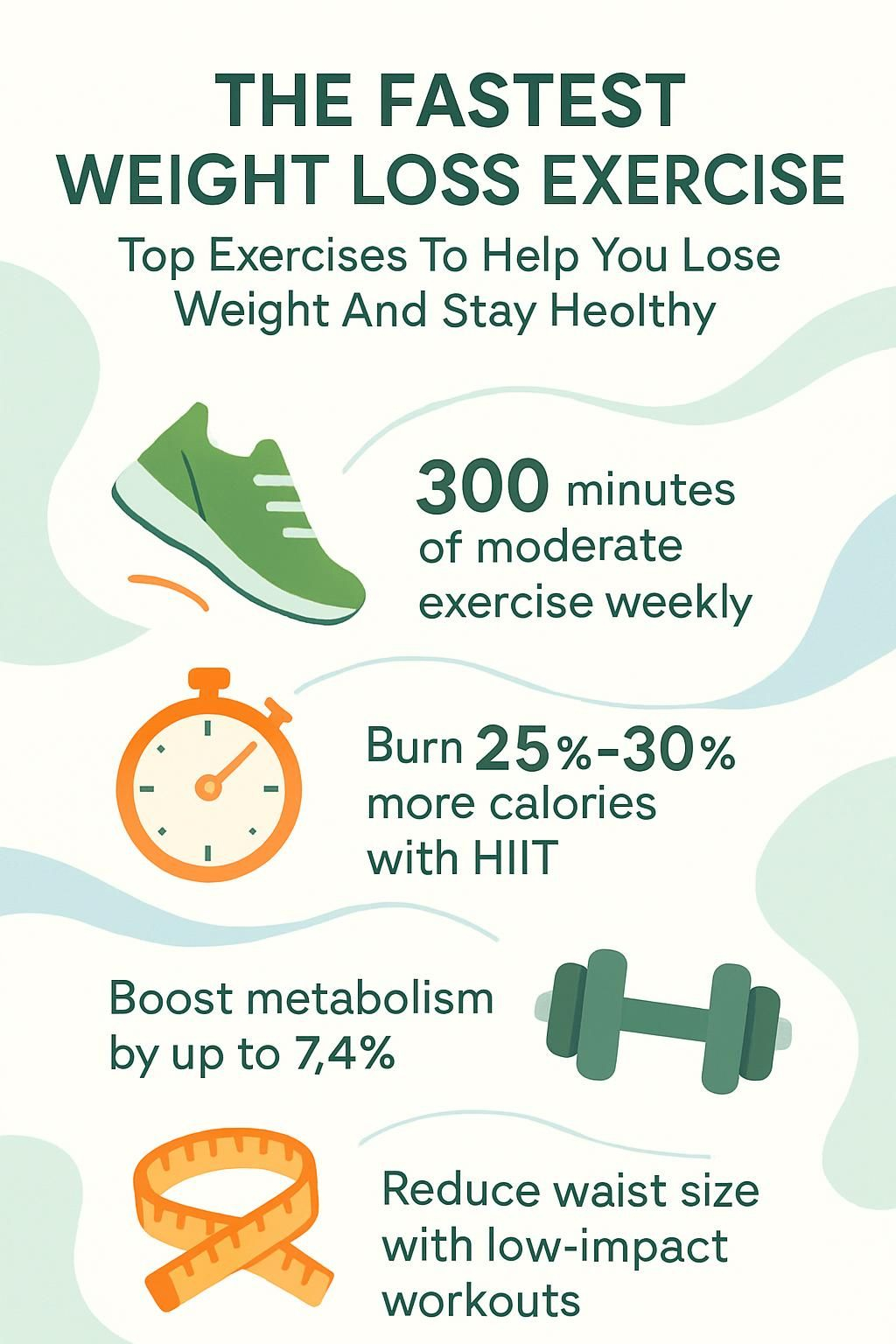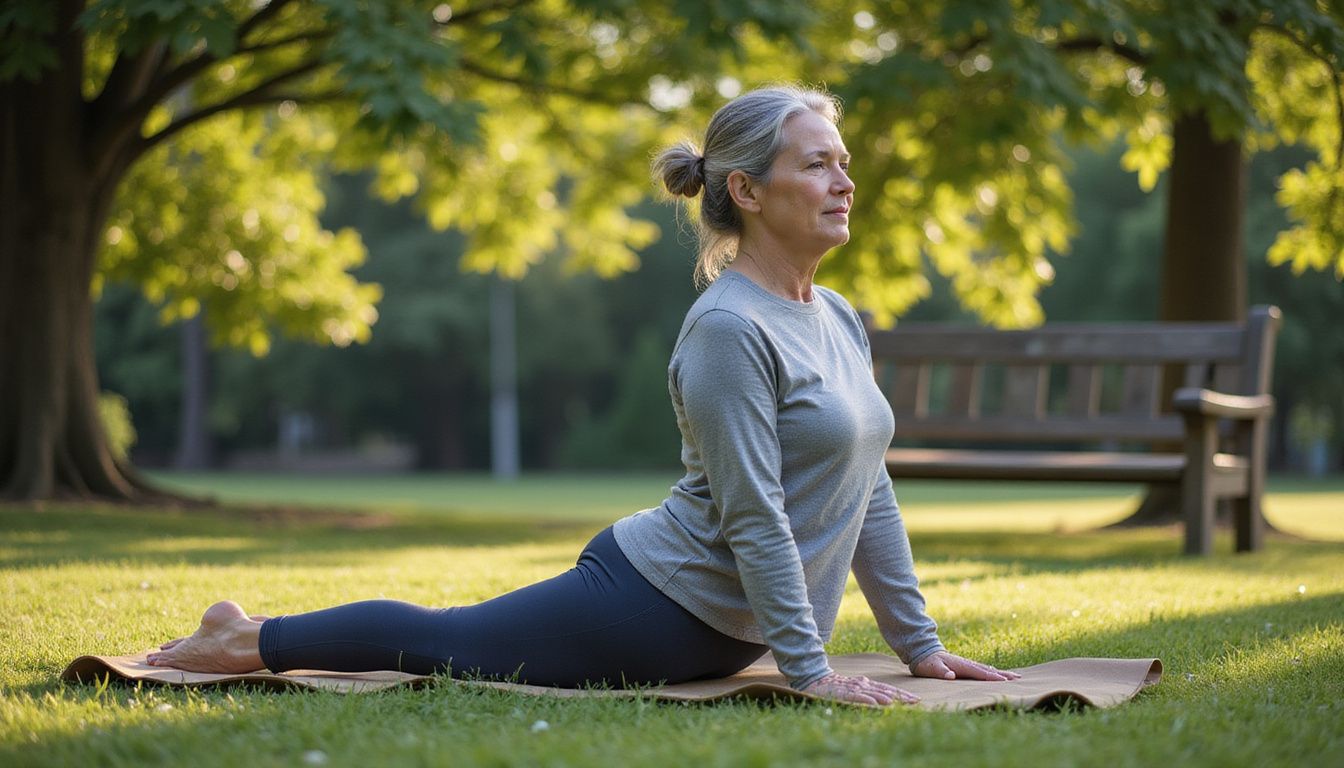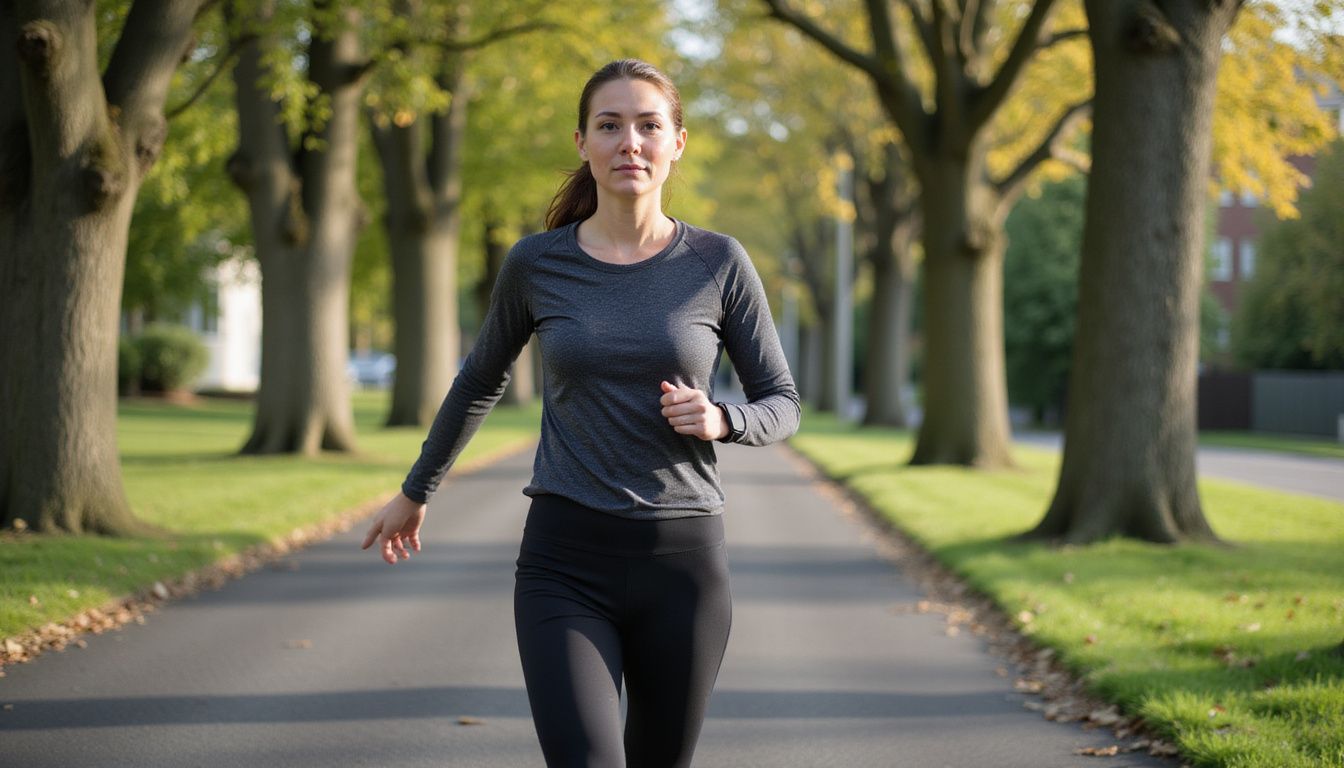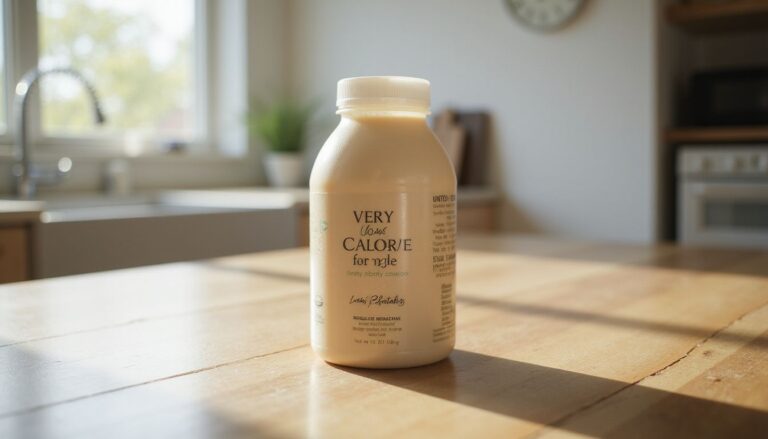The Fastest Weight Loss Exercise: Top Exercises To Help You Lose Weight And Stay Healthy
Our Nutrition Assistant AI Suite will transform your body. You will lose fat, get toned, and build muscle. Gain confidence and optimal health.
You want results, and waiting is hard. The right exercise for weight loss can speed progress and protect your health. Research supports smarter training choices, such as high-intensity intervals and strength work, to help you burn more calories and keep weight off.
This guide outlines the Fastest Weight Loss Exercise options, explains calorie burn in plain terms, and shows how to pick routines that fit your life. Simple tips below can help you move forward with confidence.
Key Takeaways
- Aim for at least 300 minutes of moderate exercise weekly. Studies and CDC guidance link this to fat loss and a lower BMI.
- High-intensity training such as HIIT or running can burn about 25 to 30 percent more calories per minute than steady cardio, which speeds weight loss.
- Strength training may raise resting metabolism by up to 7.4 percent in six months, and it helps you keep muscle while you lose fat.
- Low-impact options like Pilates or yoga can reduce waist size and improve consistency, including for older adults.
- Pair regular exercise with balanced meals, steady hydration, and planned rest. This mix supports safer, longer lasting weight control.

Why Is Exercise Important for Weight Loss?

Exercise supports healthy weight loss and helps prevent regain. Activities such as brisk walking, cycling, or swimming increase daily calorie use and improve metabolism, the process your body uses to convert food into energy.
Evidence shows that 300 minutes a week of moderate exercise leads to larger fat reductions and a lower body mass index. Regular cardio, like jogging or swimming, also improves insulin sensitivity, heart health, and cholesterol.
Movement does more than burn calories. It lowers stress, supports mental health, and can reduce blood pressure, which makes it easier to stay consistent.
I started with light cardio five days a week, then added Pilates on weekends. After three months, my waist steadily shrank, even without strict dieting.
Research in inactive adults shows consistent exercise can reduce body fat, even when diet changes are small.
Consistent movement helps you lose pounds, and it builds daily habits that keep you strong for years.
Key Factors When Choosing Weight Loss Exercises
Your best plan matches your goals, fitness level, and what you enjoy. Use the factors below to shape an exercise routine you can maintain for months, not days.
Which Exercises Burn the Most Calories?
High-intensity interval training, called HIIT, burns the most calories in short sessions. Per minute, HIIT can outpace weight training, cycling, and running.
Running above 6 miles per hour can burn about 13.2 calories per minute for a 140 pound person and up to 17 calories per minute at 180 pounds. Jumping rope also delivers high burn and often beats treadmill walking of the same duration.
Swimming is joint friendly and efficient. At a moderate front crawl, a 140 pound person may burn about 9 calories per minute. Someone at 180 pounds may use around 11.6 calories per minute.
Burpees, a combo of squats, push-ups, and jumps, raise intensity across many muscles. Strength training builds muscle tissue, which uses energy even at rest, adding to your daily burn over time.
How Do You Engage the Whole Body During Exercise?
Jumping rope works your core, shoulders, arms, and legs together. It improves coordination and can burn roughly 13.9 calories per minute at higher effort.
Swimming recruits the upper and lower body in every stroke. Options like backstroke or butterfly can burn 8 to 11 calories per minute depending on pace.
Burpees target many areas at once, which supports both strength and cardio fitness. Kickboxing blends punching and kicking with quick footwork, a full-body mix that also builds endurance.
Stationary cycling is low impact, and adding intervals or short standing climbs can engage more muscles and raise calorie burn.
I did not expect burpees to matter so much. After two weeks, my energy went up and workouts felt stronger.
Pilates strengthens the core and the smaller stabilizers that support posture and balance. Studies show Pilates can improve body composition in inactive adults within eight weeks.
HIIT alternates hard efforts with easy moves, so large muscle groups work quickly and efficiently. Add new exercises slowly and use form checks to avoid strain.
How Can You Stay Consistent with Your Workouts?
Begin with 30 minute sessions, three or four days a week. Increase time and intensity as your stamina grows.
Use simple daily moves, like walking breaks or taking the stairs, to stay active between workouts. These habits make consistency easier.
Mix in enjoyable activities such as dancing or local hikes. Add a brief warmup, like arm crossovers and torso turns, to reduce injury risk.
Try low-impact classes, including Pilates or yoga, which are easier to schedule and repeat. This approach builds a routine you can keep.
Next, see which cardio choices deliver fast results while supporting whole-body health.
Best Cardio Workouts for Quick Weight Loss
Cardio builds a stronger heart and helps you lose weight. Choose the format that fits your joints, schedule, and motivation.
Is Brisk Walking Effective for Weight Loss?
Yes. A 30 minute brisk walk can add about 150 calories burned to your day. A 140 pound person may burn about 7.6 calories per minute, while a 180 pound person may burn near 9.7 calories per minute.
Walking can reduce belly size and support a healthy weight. In one study, women with obesity walked 50 to 70 minutes, three times weekly, for 12 weeks and lost body fat and inches from the waist.
Start with 30 minutes, three or four days a week. Increase time as fitness improves and your resting burn, called basal metabolic rate, rises.
Many people begin with walking, then add jogging for more calorie burn when ready.
How Does Running or Jogging Help You Lose Weight?
Jogging burns more calories than walking. At 4 to 6 mph, someone who weighs 140 pounds may burn about 10.8 calories per minute and about 13.9 calories per minute at 180 pounds.
Running above 6 mph increases this rate. A 140 pound runner may burn near 13.2 calories per minute, and a 180 pound runner may reach 17 calories per minute.
Jogging also keeps your burn slightly elevated for up to a day after, a response called excess post-exercise oxygen consumption. This can trim deep belly fat that links to heart disease.
Soft surfaces like grass or trails can reduce joint stress. I switched from brisk walks to 30 minute jogs three times a week on a nearby trail. I dropped almost five pounds in a month with only small diet changes.
Aim for 20 to 30 minutes, three or four times a week, and increase time as your fitness improves.
Can Rope Jumping Boost Your Weight Loss?
Yes. Skipping often burns more per minute than treadmill walking. You may burn up to 11.6 calories per minute with focused effort compared with about 7.6 calories per minute while briskly walking.
Jump rope uses your legs, core, and upper body at once. A rope is low cost and portable, so it works at home or outdoors.
When I added short rope sessions, my weekly loss sped up compared to jogging alone. The American Council on Exercise lists jumping rope as an efficient cardio choice that also improves coordination.
What Are the Benefits of Biking for Weight Loss?
Cycling burns a high number of calories in a short time. At 10 mph, a 140 pound rider may burn about 6.4 calories per minute. A 180 pound rider may burn about 8.2 calories per minute.
Over an hour, this can total roughly 400 to 750 calories, depending on speed and terrain. Cycling also raises insulin sensitivity and supports heart health. It is low impact, which helps protect your joints.
Group rides can build accountability. I found weekend rides kept me consistent and helped me bike more often during the week.
How Does Swimming Support Fitness and Weight Loss?
Swimming burns calories without pounding your joints. At a moderate crawl, a 140 pound person may burn about 9 calories per minute and a 180 pound person about 11.6 calories per minute.
Regular sessions help with weight loss and heart fitness. One study of adult women who swam 60 minutes, three times weekly, for 12 weeks, reported lower body fat and improved heart markers.
Swimming can also lower LDL cholesterol and support blood pressure. I moved to the pool when my knees hurt from running. Water supported my body and kept training comfortable.
High-Intensity Workouts for Optimal Weight Loss
Short, focused bursts can deliver big returns. Think of these as sprints for your fitness.
What Is High-Intensity Interval Training (HIIT)?
HIIT alternates short hard efforts with easy efforts or rest. A session often lasts 10 to 30 minutes, which makes it time efficient.
For example, pedal hard for 30 seconds on an elliptical trainer, then recover for one to two minutes. Repeat for several rounds.
Research shows HIIT can burn about 25 to 30 percent more per minute than steady cycling or running. Your body may also burn slightly more after the workout as it returns to normal.
Studies link HIIT to smaller waistlines in both men and women. Add short sprints or rope intervals if you want fast results without longer gym visits.
How Does Sprinting Help You Lose Weight Faster?
HIIT often uses sprints of a few seconds to a minute. These raise your heart rate quickly and engage both aerobic and anaerobic systems. Anaerobic efforts use stored energy in muscles for short bursts.
Sprints recruit many muscles and burn calories fast. Short rests keep the intensity high and the session brief.
After intervals, your body works a bit harder for hours as it recovers. This afterburn can add to your total daily burn more than steady work of the same length.
If you want to lose weight with less time, add sprint sessions on a track, bike, or rower once or twice a week.
Why Are Burpees Good for Weight Loss?
Burpees combine a squat, a plank or push-up, and a jump. This whole-body move raises your heart rate and challenges many muscles at once.
Compound moves, which use multiple joints and muscles, tend to burn more per minute. They can also improve cardio fitness and strength in a single set.
Adding sets of burpees made my workouts more intense and helped me lean out faster than steady cardio alone. Many coaches suggest building to at least 150 minutes per week of mixed training if weight loss has been slow.
How Can Kickboxing Aid in Weight Loss?
Kickboxing blends cardio and strength. Punches, kicks, and footwork keep your heart rate up while training your arms, legs, and core.
Sessions can approach 750 calories per hour for higher body weights and strong effort. You also gain both aerobic and anaerobic benefits, so you may continue to burn some extra calories after class as you recover.
Kickboxing scales well. Beginners can shorten rounds. Advanced users can add resistance or increase interval time.
Incorporating Strength Training in Your Weight Loss Plan
Strength work is your ally. It protects muscle, raises your resting burn, and shapes your body as the scale moves.
How Does Lifting Weights Help with Weight Loss?
Lifting builds muscle and improves strength. During a session, a 140 pound person may burn about 7.6 calories per minute. A 180 pound person may use up to 9.8 calories per minute.
Training three to five times per week for about an hour can create meaningful change. Studies report resting metabolism can rise by about 7.4 percent after six months of consistent training, which may equal roughly 125 more calories burned per day.
Some research in men over 24 weeks found increases near nine percent. Women see similar gains with steady practice. I noticed my clothes fit looser before the scale moved after I added regular lifts.
Strength training helps preserve lean tissue, which matters for long-term maintenance.
References: [1] Six month resistance training and resting metabolic rate. [2] Twenty four week weight training in adults and energy expenditure.
Can Body Weight Exercises Build Strength and Burn Fat?
Yes. Moves like squats, push-ups, lunges, and burpees use your body as resistance. They require no gear and can be done almost anywhere.
Compound bodyweight exercises recruit many muscles at once, which raises calorie burn per set. High intensity moves, such as jumping lunges, also improve cardio fitness.
Evidence shows Pilates can improve body composition in middle-aged women. Planks build core stability, which supports posture and daily tasks.
A simple plan built around these movements can deliver steady strength and fat loss if you practice with good form and a consistent schedule.
What Are the Benefits of Using Resistance Bands?
Resistance bands provide adjustable tension for presses, rows, and squats. Studies show bands can increase muscle activation and support strength gains in a convenient format.
Bands are portable and affordable, which supports regular training at home or on the road. They also fit all levels, from beginners to advanced lifters.
Many adults stick with exercise longer when setup is easy. I keep a set of bands in my bag, which helps me stay on track during busy weeks.
Source: National Strength and Conditioning Association, Strength Training With Resistance Bands, 2022.
Accessible Low-Impact Workouts for All Fitness Levels
Low-impact choices protect your joints and support steady progress. These are friendly options for busy weeks or recovery days.
How Does Pilates Support Weight Loss?
Pilates targets the core and improves total body control. In 30 minutes, a 140 pound person might burn about 108 calories in a beginner class and up to 168 in an advanced class.
An eight week program of 90 minute classes, three times per week, reduced waist, belly, and hip size in one study. Many people also report less back pain and better posture.
I joined a weekly class with a local group and felt less stiffness after four sessions. The gentle style made it easier to keep showing up.
Can Yoga Help You Lose Weight and Improve Flexibility?
Yes. Practicing yoga for 30 minutes a week has been linked to lower BMI and better eating habits. In one trial, two 90 minute sessions each week for 12 weeks reduced waist size by up to 1.5 inches.
Yoga burns calories, improves flexibility, and eases stress. Lower stress can reduce emotional eating and snack cravings.
Combining yoga with other workouts can support lasting results while keeping muscles flexible and strong.
Is Climbing Stairs an Effective Low-Impact Exercise?
Stair climbing is simple, quick, and requires no equipment. Even short daily bouts can add up and fit into a busy day.
Research suggests that climbing only a few flights each day can support weight control across a year. It also strengthens heart, bones, and leg muscles with a lower impact than running.
I used office stair breaks for quick sessions. My legs grew stronger and I stayed active even on meeting heavy days.
How Does Using the Elliptical Machine Aid Weight Loss?
An elliptical delivers cardio with less joint stress than running. You can adjust resistance and incline to match your fitness level.
It engages both upper and lower body, which can increase total calorie burn. People with knee or foot pain often find the elliptical easier to repeat week after week.
During a foot injury, I used the elliptical to stay active without pain. Gradually raising speed or incline creates simple challenges that show progress.
Fun Outdoor Activities That Aid Weight Loss
Fresh air can lift your mood and your step. Outdoor movement also keeps motivation high.
What Are the Weight Loss Benefits of Hiking Trails?
Hiking over hills burns more than walking on flat ground. A 160 pound person may burn about 430 to 440 calories per hour on moderate terrain.
Trail changes target your legs, core, and stabilizers with every step. The scenery helps the time pass and can make longer sessions feel easier.
Weekend hikes helped me drop 10 pounds in one summer without feeling stuck indoors.
How Does Rowing on Water Help Burn Calories?
Rowing works your legs, core, back, and arms in every stroke. Using many muscles at once increases calorie burn and improves cardio fitness.
Water adds natural resistance, so effort stays high even at steady speeds. Short, hard intervals on the water can support fast progress.
Can Playing Sports Like Tennis or Soccer Help You Lose Weight?
Yes. Sports like tennis and soccer mix longer efforts with quick bursts. This blend builds endurance and strength and keeps the session engaging.
Games are social, which can improve consistency. I stuck with weekend soccer because it felt fun, and that helped me stay active all week.
Next, learn small strategy tweaks that make the most of your hard work.
Strategies to Enhance Weight Loss With Exercise
Smart daily choices amplify your training. Think of these steps as simple tools that stack in your favor.
How Do You Balance Exercise with a Nutritious Diet?
Pair workouts with meals that feature whole foods, lean protein, vegetables, fruits, and fiber rich carbs. Weight loss needs a calorie deficit, meaning you burn more than you eat.
Research shows that exercise plus healthy meals works better than either alone. A simple app or food log helps you stay aware of portions.
Eat balanced snacks before and after sessions to support energy and recovery. If you need a personal plan, ask a registered dietitian for guidance.
Why Is Staying Hydrated Important for Weight Loss?
Water supports metabolism and energy during exercise. Even mild dehydration can hurt performance and slow recovery.
Drinking water before meals may help reduce calorie intake. Staying hydrated also lowers fatigue and the risk of cramps during intense work like HIIT.
How Much Rest and Recovery Do You Need?
Plan three to five strength sessions a week with rest days between them. Muscles grow and repair during recovery, which prepares you for the next workout.
Sleep supports hormones that control appetite and energy. Aim for at least seven hours most nights to protect progress.
Strong recovery habits make consistency possible. They also reduce injury risk from doing too much too soon.
How Can You Monitor Your Fitness Progress Effectively?
Track simple measures once a week, such as waist size, body weight, and how hard workouts feel. Many people see early changes in 4 to 6 weeks.
Keep a short workout log with the type of exercise, duration, and intensity. If possible, schedule check-ins with a healthcare professional for body fat or other health markers.
These numbers help you adjust training or meals and keep you focused on what works.
How Much Exercise Do You Need to Lose Weight?
For steady loss, aim for at least 300 minutes of moderate exercise each week. That equals about 60 minutes a day, five days a week. Health agencies, including the CDC, support this target for most adults.
Moderate choices include brisk walking, light cycling, or swim laps. If you use higher intensity options, such as running or HIIT, you can meet calorie goals in less time.
Results vary based on your starting weight, age, sex, genetics, and health. Most people do best with a mix of cardio and strength, which helps raise muscle mass and increases daily burn, even at rest.
What Are Common Mistakes to Avoid in Weight Loss Workouts?
Planning helps you avoid common traps that stall progress or harm your health.
- Chasing rapid results can lead to muscle loss, dehydration, hair loss, gallstones, or fatigue. Aim to lose 1 to 2 pounds per week for safety.
- Skipping rest days raises injury risk and burnout. Muscles need recovery time to adapt.
- Shorting sleep lowers energy and raises cravings. Target seven or more hours nightly.
- Overlooking medical issues such as depression or thyroid problems may slow progress. Seek medical advice if weight is not changing despite solid habits.
- Exercising without diet changes limits results. Weight loss requires both calorie burn and healthy eating.
- Not hydrating can cause headaches, constipation, fatigue, and poor performance. Drink water before, during, and after workouts.
- Only doing cardio or only doing strength slows fat loss and can reduce muscle gains. Combine both.
- Setting goals that are too big can frustrate you. Choose small, specific targets and build step by step.
- Tracking too rarely hides what works. Use a simple journal or app each week.
Continue reading to learn how much exercise you actually need for effective weight loss results.
Conclusion
The fastest path is not a single move, it is a smart mix. Blend cardio, strength training, and low-impact options you enjoy. Brisk walking, jumping rope, and cycling can burn calories quickly. Strength work and HIIT raise metabolism so you keep burning after sessions. Gentle Pilates or yoga support joint comfort and consistency.
Choose a routine you can keep. Pair training with nourishing meals, steady hydration, and solid sleep. If you have a medical condition or take medication, speak with a healthcare professional before making big changes. With a clear plan and patience, you can lose weight and build lasting health.
FAQs
1. What is the fastest exercise for weight loss and why does it work?
Running is often considered the fastest exercise for weight loss because it burns a high number of calories in a short time. According to Harvard Medical School, a person weighing 155 pounds can burn about 372 calories by running at 6 miles per hour for 30 minutes. This activity increases heart rate and uses many muscle groups, which helps burn fat more efficiently.
2. Which exercises help you lose weight while also improving overall health?
Swimming, cycling, brisk walking, and interval training are effective choices that support both weight loss and cardiovascular health. Studies show that these activities improve endurance and lower risk factors linked to chronic diseases such as diabetes or hypertension.
3. How much should I exercise each week to see results in weight loss?
Experts recommend at least 150 minutes of moderate aerobic activity or 75 minutes of vigorous activity each week for noticeable changes in body composition. For example, five sessions of brisk walking or three sessions of intense cycling can meet this guideline.
4. Can personal experience influence which exercise works best for losing weight?
Personal preference plays an important role when choosing an exercise routine; enjoyment leads to consistency over time. For instance, after trying several activities myself, I found swimming most sustainable due to its low impact on joints and full-body engagement.
Summary: Running offers quick calorie burning; swimming, cycling, walking, and intervals promote both fitness and health; regular weekly activity supports steady progress; personal choice ensures long-term commitment to any workout plan.







